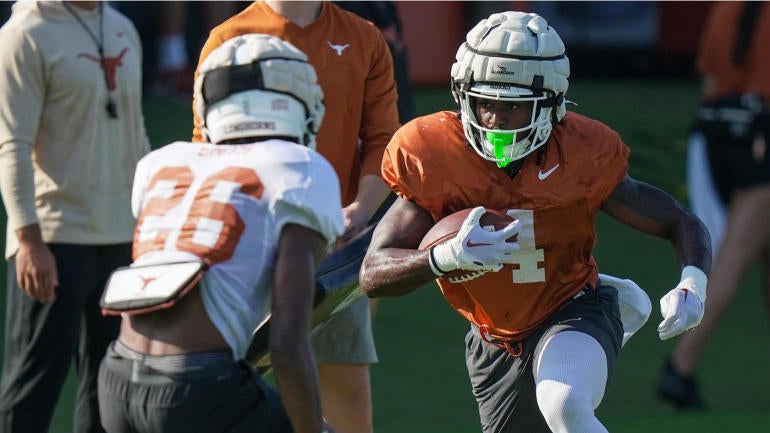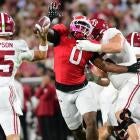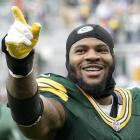Can players lose NIL money if they're injured? Here's what collectives say
To an extent there's any uniformity, there are variables to whether an injury docks a player NIL payment -- including where the injury took place. And of course, there's insurance involved

Injuries are an unfortunate part of life in a violent sport. Fall camp alone saw notable season-ending injuries to two Texas running backs, Texas A&M running back Reuben Owens, Notre Dame left tackle Charles Jagusah, and Rutgers linebacker Mohamed Toure. But in the Name Image and Likeness world with contracts between collectives and athletes, an injury doesn't just hinder your availability on the depth chart. So how do collectives handle players that get hurt, especially when they're out for an entire year?
As is the case with many cases in the collective world, it runs the gamut. One Power 4 collective official told CBS Sports that their contracts don't have anything in them related to performance, and that they stick strictly to the deliverables such as appearances in the community or social media posts. Another former Power 4 collective official told CBS Sports the most popular plan to handle injuries in the industry is to not have a plan at all, "which continues to shock me." It echoes one NIL agent who said he'd never seen an injury clause in a deal.
The answers speak to the lack of uniformity across the industry and the actual function of collectives. Some are marketing arms. Others function as full representatives of the university whether they're supposed to or not.
To the extent such language does exist in a contract, there are ways collectives attempt to protect themselves on the front end with vague language. For instance, if an athlete's marketability is "impaired," payment could be stopped. One could argue a lot of things could fall into the bucket of impairment, including injury.
"If I'm representing an athlete, and I see [a clause like that] in there, the first thing I'm doing is I'm asking to have it removed, because I'm not having my athlete waive their payments on the off chance that they happen to get hurt in a contact sport like that's just kind of silly to me," a different NIL agent told CBS Sports. "What I can argue is, you're at practice, he made a cut, it was non-contact cut, and he gets hurt. You're not gonna withhold my client for payment at that point because he's doing what you're asking him to do."
What's more likely is direct language about an injury that occurs off-campus among a list of other reasons a collective may withhold revenue like Georgia's fine structure for speeding.
Reads language of one Power Four collective contract shared with CBS Sports:
"Athlete is eligible to receive a deduction in payments if injured off campus, regardless of fault, or legal action that took place. Athlete is held responsible for any and all damages that may occur off campus, and will be expected to maintain good standing with university and NCAA policies and procedures barring a medical condition that prohibits the athlete from doing so. Any and all medical absences must be approved through the proper medical staff provided to the athlete on campus."
Whether a collective would ever try to enforce such a clause is another thing entirely. It would be horrific public relations and overall recruiting strategy for a collective to withhold payments because a player got injured on or off the field. In that respect, the athlete does have leverage over the collective. College sports does not have a formal injury settlement structure like the NFL does, one of many reminders that college player compensation is still in its infancy.
But collectives can take steps to backstop their investments into players. Enter a business like Players Health, whose CEO Tyrre Burks suffered multiple injuries throughout his playing career, leading him to found a business to help athletes and now collectives get insured in the event of an injury with money he says he collected from his own insurance payouts. Players Health works with 40-50 universities across various divisions, including many FBS programs tracking and managing player health data, injury reporting and compliance with safety protocols. Ten years ago, Burks started the business to build a robust HIPPA compliant injury database. Doctors, trainers, and other medical professionals can input injuries to Burks' platform, and he generates a risk profile for a given position.
"I can tell you the risk exposure of a running back that's 16-years-old," Burks said. "How many knee injuries that we've had, and what the trends are for knee injuries we have over within our database. We have over 30,000 knee injuries that have been documented. That's just an example of one injury that we have a really clear understanding of."
Now Players Health is moving towards insuring athlete value. Their basic liability insurance offered backstops up to $25,000 of value with policies that can be purchased by either a collective or an athlete themself if the athlete missed more than 25% of their playing season after an injury that happens in a practice or game. A policy at a higher valuation can also be purchased for the top earners on a team and premiums can vary significantly based on players' age, medical history, geographic location, length of the season, and more.
"The way that I view insurance within the collegiate space is it's risk management," Burks said. "This is true investment going into these athletes. And how does the collective think about how they're going to be managing those dollars? And then, how should the athlete be thinking about the risk that they currently have as well? We want to give everybody visibility on the injury risk that they have, and then, based on that visibility they may want to buy insurance."
With revenue sharing on the horizon, player compensation will become more sophisticated in college athletics, as will the actual purpose of what a collective actually does. Injury is inherent to physical activity, but how schools and athletes handle them doesn't have to stay the same as it always has been.
John Talty contributed reporting


















